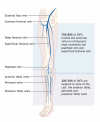Diagnosis and treatment of deep-vein thrombosis
- PMID: 17060659
- PMCID: PMC1609160
- DOI: 10.1503/cmaj.060366
Diagnosis and treatment of deep-vein thrombosis
Erratum in
- CMAJ. 2007 Nov 20;177(11):1392
Abstract
Deep-vein thrombosis (DVT) is a common condition that can lead to complications such as postphlebitic syndrome, pulmonary embolism and death. The approach to the diagnosis of DVT has evolved over the years. Currently an algorithm strategy combining pretest probability, D-dimer testing and compression ultrasound imaging allows for safe and convenient investigation of suspected lower-extremity thrombosis. Patients with low pretest probability and a negative D-dimer test result can have proximal DVT excluded without the need for diagnostic imaging. The mainstay of treatment of DVT is anticoagulation therapy, whereas interventions such as thrombolysis and placement of inferior vena cava filters are reserved for special situations. The use of low-molecular-weight heparin allows for outpatient management of most patients with DVT. The duration of anticoagulation therapy depends on whether the primary event was idiopathic or secondary to a transient risk factor. More research is required to optimally define the factors that predict an increased risk of recurrent DVT to determine which patients can benefit from extended anticoagulant therapy.
Figures
References
-
- White RH. The epidemiology of venous thromboembolism. Circulation 2003;107(Suppl 1):I4-8. - PubMed
-
- Silverstein MD, Heit JA, Mohr DN, et al. Trends in the incidence of deep vein thrombosis and pulmonary embolism: a 25-year population-based study. Arch Intern Med 1998;158:585-93. - PubMed
-
- Hirsh J, Bates SM. Prognosis in acute pulmonary embolism. Lancet 1999;353:1375-6. - PubMed
-
- Prandoni P, Lensing AWA, Prins M. Long-term outcomes after deep venous thrombosis of the lower extremities. Vasc Med 1998;3:57-60. - PubMed
-
- Fedullo PF, Auger WR, Channick RN, et al. Chronic thromboembolic pulmonary hypertension. Clin Chest Med 2001;22:561-81. - PubMed
Publication types
MeSH terms
Substances
LinkOut - more resources
Full Text Sources
Medical


